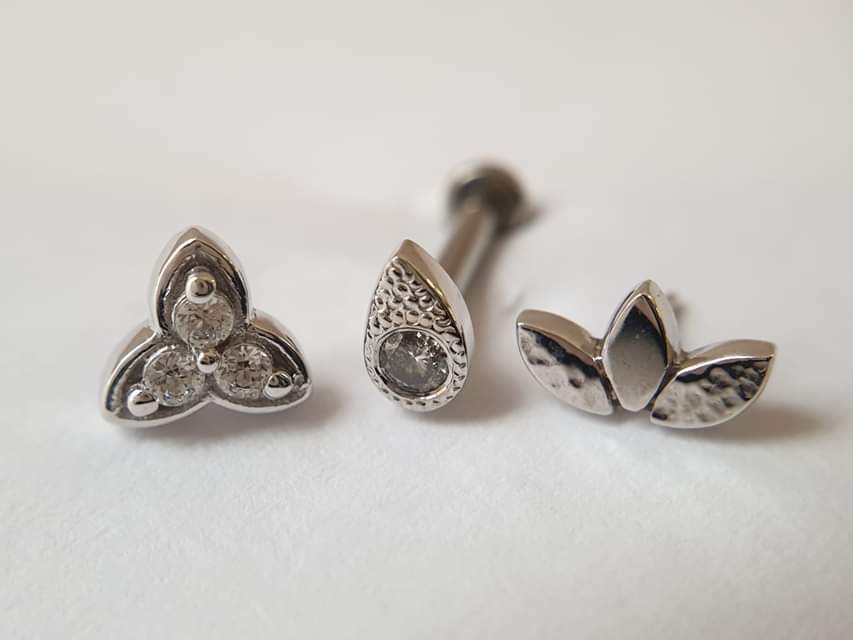
Labret posts seem like humble little pieces of metal but they are the true workhorses of the piercing world. This week we will be looking at the importance of labret posts, why they are the shape they are and why we love them so much!
So to start with lets refresh on what a labret is. It is a Post with a disc on one end. The disc can be fixed or removable and they post can be threaded or threadless. The labret post is the part which passes through your body and the part that holds all the beautiful ends in place. Many different manufacturers make labrets but sadly not all are made equal. For a refresh on all of the different aspects of high quality jewellery then take a look back at our High Quality? Series of Blogs here.
Importance
Labret posts are one of the key reasons we have so many piercing and jewellery options available to us. Before labret studs the only options were rings and barbells. By changing the ball on a barbell to a disc, piercers were able to offer piercings in much smaller placements e.g. forward helix, with less space at the back e.g the labret piercing and for more comfort e.g. sleeping on lobe piercings.
Design

While they may seem simple there are a lot of design constraints. A labret must be sized correctly in post length and gauge, connection choice and disc diameter and thickness.
Length

The length of the post for a jewellery maker is more than the piercer approach of ensuring the jewellery is long enough to not embed and not too long so it snags. The gauge of the post must be thick enough that a suitable thread can be placed inside with enough metal left to support the thread without breaking. 1.6mm/14g barbells were already around when labrets were invented but as demand grew for 1.2mm/16g and 1.0mm/16g jewellery the labret was ready to take the top spot.
Connection

Connection choice might seem simple. Just drill a hole either small enough for threadless or large enough to tap a thread. But threadless has been under patent since the early 90’s and has only just entered public license so this wasn’t an option for most manufacturers. For threaded pieces large taps could easily break the labret and smaller thread patterns can be weak and easily stripped. The solution was to settle on an unusual thread pattern for the smaller bars. 000-120 for 1.2mm/16g and 1.0mm/18g. For the larger 1.6mm/14g and 2.0mm/12g a much more readily available thread pattern of M1.2 is used. To top all of this off if the labret has got a removable disc then the post has to be long enough the the holes drilled for threadless of threaded don’t meet in the middle. Since threadless has become public domain we have seen a lot of advancement in the miniaturisation of jewellery and a rise in the popularity of smaller piercing sites such as forward helixes.
Disc Size

The Disc on a labret has 3 main dimensions; diameter, thickness and angle.
The diameter is important because it is used to balance the weight of the end placed on the labret. If the disc doesn’t balance then gravity will pull the jewellery down and the edge of the disc will start to irritate the piercing site. Diameter is also especially important during the initial healing phase as it prevents the body swelling over and embedding the jewellery. Conversely a disc that is too large will be pulled down by gravity and can pull the end into the body. It is all a balancing act.
Thickness of the disc can help to minimise any irritation of the jewellery in the body. If the disc is too thin it will essentially be knife edge scraping and cutting the piercing site all day. If it is too thick then it creates a corner that acts the same as a thin disc. The key here is ti find the balance in the middle and then polish the edges so that there are no sharp points that could hurt the piercing.
By angle of the disc we mean the angle from the post to the edge of the disc. We don not mean the angle of the post coming out of the disc. An easy visual of this is a Flat Disc compared to an M&M Disc. The reason for different angles is to allow space between the piercing and jewellery for drainage, to minimise sharp edges in soft tissue e.g. tongue piercings and to give more weight to balance larger ends.
When your piercer selects the labret post for your piercing they are taking all of this and more into consideration. No two bodies are alike and so our body jewellery has to be as unique as we are. Just remember that your piercer will pierce you with initial size and for comfort and a happy, healthy piercing you will need to go back for a downsize.
So hopefully we’ve shown you that we love labret posts. Without this humble piece of jewellery the world of piercing would be a much duller place! We’ll be back next week with another lockdown blog. Stay safe everyone!


































